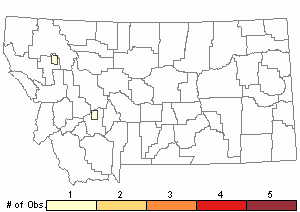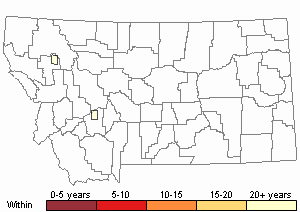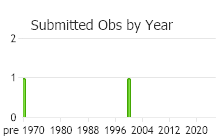View in other NatureServe Network Field Guides
NatureServe
Montana
Utah
Wyoming
Idaho
Wisconsin
British Columbia
South Carolina
Yukon
California
New York
A Thread Moss - Ditrichum heteromallum
General Description
Plants: Acrocarpous, growing in open to crowded clumps of erect shoots (FNA 2007), sometimes well-scattered (Lawton 1971), green with yellow tones above, somewhat ochre or brown below. Stems mostly single, sometimes reaching 10 mm in height, possessing a central strand; rhizoids occurring at the bottom of the stem (FNA 2007).
Leaves: Generally upright or spreading to about 45 degrees (FNA 2007), sometimes tending to point toward the same side of the stem (Lawton 1971), the somewhat egg-shaped base steadily narrowing to a subula, the subula long and with a longitudinal groove; margins flat (FNA 2007) or curved up and inward, sometimes slightly dentate distally but otherwise smooth; costa extending to the apex or beyond (Lawton 1971), largely filling the subula (FNA 2007).
Leaf Cells: Lamina 2 cell-layers thick above; distal laminal and subular cells somewhat long and quadrangular, becoming longer near the bottom of the leaf, occasionally papillose and more often near the leaf tip; margins 2 cell-layers thick in the upper half, 1-layered below; costa in X-section with guide cells in 1 row, a weak ventral stereid band and a well-defined dorsal stereid band (FNA 2007).
Phenology
Fruit ripens in early- to mid-summer (FNA 2007).
Diagnostic Characteristics
The similar Ditrichum flexicaule often can be distinguished by its marginal cells near mid-leaf, which are isodiametric or nearly so, or lengthened crosswise to the leaf. Those of D. heteromallum are long (Lawton 1971).
Range Comments
North American Range
AK, BC s to OR (FNA 2007). Known in Montana from Flathead and Lewis and Clark Counties (Elliott & Pipp, 2016).
Observations in Montana Natural Heritage Program Database
Number of Observations: 2
(Click on the following maps and charts to see full sized version)
Map Help and Descriptions
Relative Density

Recency



 (Observations spanning multiple months or years are excluded from time charts)
(Observations spanning multiple months or years are excluded from time charts)
Habitat
Damp (Elliott & Pipp, 2016), often disrupted, bare, or finely- to coarsely-textured soil and gravel on embankments, roadsides, open spaces in woods (FNA 2007). Ranging in elevation from low-lying areas to occasionally over 4920 feet (Lawton 1971).
Reproductive Characteristics
Dioicous. Perichaetial leaves enveloping the stem (Lawton 1971). Seta, russet, 1-2.5 mm in height, carrying the capsule beyond the perichaetial leaves. Capsule upright, russet, 0.5-1.5 mm in length (FNA 2007), straight, frequently the mouth smaller in diameter (Lawton 1971); peristome single, the 16 teeth (FNA 2007) 2-fid and split almost to the base (Lawton 1971), weakly papillose, light orange. Calyptra draping like a hood (FNA 2007).
Specialized vegetative reproduction occurring rarely from tubers produced by the rhizoids, the tubers looking short and filamentous with enlarged, deformed rhizoid cells (FNA 2007).
Stewardship Responsibility
References
- Literature Cited AboveLegend:
 View Online Publication
View Online Publication Elliott, J.C. and A.K. Pipp. 2018. A Checklist of Montana Mosses (1880-2018). Updated 3 January, 2020. Montana Natural Heritage Program, Helena, Montana. 73 pp.
Elliott, J.C. and A.K. Pipp. 2018. A Checklist of Montana Mosses (1880-2018). Updated 3 January, 2020. Montana Natural Heritage Program, Helena, Montana. 73 pp. Flora of North America Editorial Committee, eds. 2007. Flora of North America North of Mexico. Volume 27. Bryophytes: Mosses, Part 1. Oxford University Press, Inc., NY. xxi + 713 pp.
Flora of North America Editorial Committee, eds. 2007. Flora of North America North of Mexico. Volume 27. Bryophytes: Mosses, Part 1. Oxford University Press, Inc., NY. xxi + 713 pp. Lawton, E. 1971. Moss Flora of the Pacific Northwest. Hattori Botanical Laboratory. Japan: Yamabuki-cho, Shinjuku-ku, Tokyo. 362 pages plus appendices.
Lawton, E. 1971. Moss Flora of the Pacific Northwest. Hattori Botanical Laboratory. Japan: Yamabuki-cho, Shinjuku-ku, Tokyo. 362 pages plus appendices.
- Additional ReferencesLegend:
 View Online Publication
View Online Publication
Do you know of a citation we're missing? Elliot, J. C. 1993. Second checklist of Montana mosses. Unpublished report. U.S. Forest Service, Region 1. Missoula, MT. 45 pp.
Elliot, J. C. 1993. Second checklist of Montana mosses. Unpublished report. U.S. Forest Service, Region 1. Missoula, MT. 45 pp. Lawton, E. 1971. Keys for the Identification of the Mosses on the Pacific Northwest. Reprinted from 'Moss Flora of the Pacific Northwest'. Published as Supplement No. 2 of the Journal of the Hattori Botanical Laboratory. Nichinan, Miyazaki, Japan. 66 pp.
Lawton, E. 1971. Keys for the Identification of the Mosses on the Pacific Northwest. Reprinted from 'Moss Flora of the Pacific Northwest'. Published as Supplement No. 2 of the Journal of the Hattori Botanical Laboratory. Nichinan, Miyazaki, Japan. 66 pp. Malcolm, B., N. Malcolm, J. Shevock, and D. Norris. 2009. California Mosses. Nelson, New Zealand: Micro-Optics Press. 430 pp.
Malcolm, B., N. Malcolm, J. Shevock, and D. Norris. 2009. California Mosses. Nelson, New Zealand: Micro-Optics Press. 430 pp. Smith, A.J.E. 1980. The Moss Flora of Britain and Ireland. Cambridge University Press, Cambridge. 705 pp.
Smith, A.J.E. 1980. The Moss Flora of Britain and Ireland. Cambridge University Press, Cambridge. 705 pp.
- Web Search Engines for Articles on "A Thread Moss"





